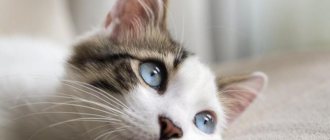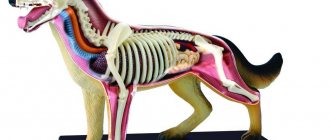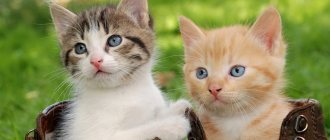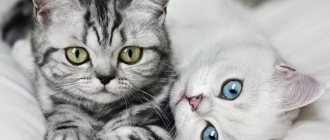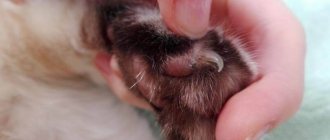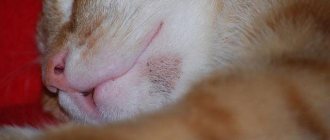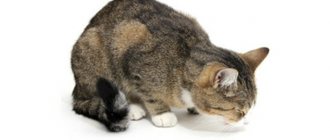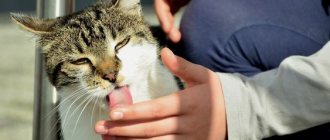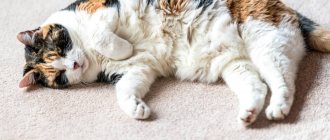Knowing the structure of the reproductive system of the cat family, it is easier for the owner to understand the behavior of his pet. The genital organs of cats are similar to those of other mammals, but they have characteristic features. The anatomy and functions of the male and female differ, but wise nature ensured that their organisms matched “like a key to a lock.” Sexual instinct is the most ancient and primary, because it promotes procreation.
Anatomy of the structure of a cat's penis
The cat's reproductive system consists of:
- testicles;
- seminal ducts;
- urogenital canal;
- testicular appendages;
- penis.
A cat's testicles produce sperm that are ready for fertilization with cat cells.
Sperm are constantly produced in the testicles, which indicates that the pet is ready to conceive. When an animal mates, sperm enter the urogenital canal, and then into the pet’s vagina. Active cat cells enter the cat's reproductive organs, after which fertilization occurs.
In males, the testicles are hidden in the scrotum (skin pouch), which is located below the anus.
Reproductive system of a cat and cat
Screams at night, marking of housing, a sharp and unpleasant smell of urine - the effect of testosterone on the pet’s body.
Basic information
This is the name for inflammation of the foreskin and glans penis . Animals of all ages are susceptible; all non-castrated cats are at risk (the latter get sick several times less often). Predisposing factors and immediate causes are the following pathologies of the reproductive system:
- Orchitis.
- Phimosis.
- Paraphimosis.
- Cryptorchidism.
- Degenerative lesions of the testes.
- Testicular tumors (not necessarily malignant).
- Prostatitis.
Note that in this case, inflammation of the foreskin does not always have an infectious etiology ; sometimes pathogenic microflora has nothing to do with it. It happens that pathology develops after exposure to some irritating substances, including some types of household chemicals. Sometimes such an “intimate” problem is caused by a sudden change in care products (shampoos, etc.) after the use of certain medications (for example, drops against ticks and fleas).
Anatomy of the structure of the feline genital organs in a cat
The reproductive system of a pet includes:
- external genitalia;
- uterus;
- ovaries;
- mammary glands (some consider them to be part of the pet’s reproductive system).
Urine is removed from the pet’s body thanks to the female’s external organs and vagina.
They are released at the moment of mating with the male, and conception occurs in the oviducts. In the uterus, the fetus continues to grow and develop.
Due to the physiological structure of the cat's body, the cervix is in a closed state - this protects the pet from foreign infections. The cervix opens only when the female goes into heat. During mating, sperm penetrate at this moment.
The horn of the uterus serves for the development of the fetus. Due to the fact that it stretches, the female is able to bear from one to eight kittens.
Cat reproductive system
The female, along with her urine, secretes hormones - estrogens, thanks to which the male receives a signal to mate. Mammary glands are necessary for feeding offspring. Four pairs of nipples are considered the norm; they are located symmetrically along the body, from the groin to the chest.
Females begin to walk one to two months after winter. During this period of time, the cat's body produces melatonin, which is responsible for the reproductive process in cats.
Development and maturation
The centers of regulation of the reproductive system are located in the brain and, through hormones, send signals to target organs - the ovaries and testes. They, in turn, produce sex cells - eggs and sperm, as well as sex hormones. A gradual increase in their production leads to sexual maturation of individuals. The development and function of the feline reproductive system is influenced by a variety of factors:
- seasonality;
- temperature regime;
- nutritional features;
- belonging to a certain breed;
- conditions of detention and care.
Before fertilization, the cat must become biologically adult.
Sexual maturity is defined as the ability to reproduce one's own kind. In males it occurs at 6-8 months of life, in females - a little earlier and is characterized by the 1st estrus. The general development of the body has not yet been completed, so early pregnancies will be defective. For breeding the breed, the best age is 8-9 months, when the cat’s weight is at least 70% of the weight of an adult and the physiological maturity of all organs and systems begins.
Genital organs in cats
The genital organs in cats are organs that produce germ cells, which excrete sexual products and are the site of fertilization and development of the embryo.
The genitals form the reproductive or reproductive system of cats.
Cats, like all mammals, have two sexes - male and female, whose genital organs are different.
How to find out the gender of a kitten
Before we continue to analyze the cat's anatomy, it's important to discuss.
You will need to first lift the kitten's tail. Both male and female cats will have an opening in the anus just below the tail. Below this, towards the belly, you can see a line that will appear to form an I, this is a vertical slit and this means your kitten is female . In the male's, however, you will notice a round protuberance that is further from the anus than the female's vulva. Additionally, as your cat gets older, you will notice the formation of his testicles...
Cat genitals
• The scrotum is a cavity of the sac-like protrusion of the abdominal wall, which ensures the maintenance of the temperature necessary for the maturation of sperm (several tenths of a degree lower than in the abdominal cavity). In cats, the muscles of the scrotum can pull it towards the groin if it is too cold outside. The scrotum is located between the penis and the anus.
• The spermatic cord is a fold of the peritoneum that contains blood vessels, nerves leading to the testis, as well as lymphatic vessels and the vas deferens emerging from it.
• The testes are paired, egg-shaped organs located in the scrotum. The diameter of each testis in cats is 1-1.5 cm. In the tubules of the testes, sperm are produced by a special epithelium.
Cat genitals
• The ovaries are a paired, bean-shaped organ located in the lumbar region of the cat. The ovaries are connected to the uterus by the fallopian tubes, where eggs mature. The ovaries consist of follicles - sacs containing eggs and fluid. When the follicle matures, it bursts and the egg with follicular fluid enters the fallopian tube (ovulation occurs). And in place of the follicle, a corpus luteum is formed, suppressing the development of other follicles. In cats, multiple follicles burst at the same time, resulting in multiple pregnancies.
• Fallopian tube (oviduct) is a narrow, convoluted tube that connects the ovary to the uterus. Fertilization occurs in the fallopian tube, after which the egg moves to the uterus.
• The uterus is a hollow, membranous organ in which the fetus develops. In cats, the uterus is bicornuate, that is, it has the shape of the Latin letter Y. Each horn (3 mm in diameter and 10 mm in length) is connected to its fallopian tube, and closer to the vagina the horns merge, forming the body of the uterus (2 cm in length). The body of the uterus gradually narrows, in turn forming the cervix, which opens into the vagina. Fruit ripening occurs in the horns of the uterus. The uterus is located in the pelvic and abdominal cavity.
• The vagina is a tubular organ designed for copulation and located between the cervix and the urogenital opening.
• Vulva – a set of external genitourinary organs (vestibule of the vagina + external opening of the urethra). Located below the anus and separated from it by a small perineum).
• The vaginal vestibule is the common part of the genitourinary tract located behind the urethral opening.
• The labia are folds of skin that protect the vestibule of the vagina.
• The genital fissure is the entrance to the vagina.
• The clitoris is a sexual organ, a rudiment of the penis in females, representing an erogenous zone. In cats, it is located in the genital cleft, and its stimulation ensures ovulation.
The genital organs of cats are similar to the genital organs of other mammals, but they have a number of features characteristic exclusively of felines.
From the beginning of estrus to the birth of kittens
Pyometra is a severe infectious disease of the endometrium, accompanied by the accumulation of pus in the uterus, which can be discharged from the vagina.
Most often, the causative agent of pyometra in cats is E.coli, a little less often - staphylococcus and streptococcus. The diagnosis of pyometra is based on the medical history, the pattern of clinical signs and the results of a complete clinical examination. Pyometra can occur in cats of any age, including those who have not given birth. Suspicion of pyometra should not be removed until this diagnosis has been completely excluded in any case of vaginal discharge in a cat.
Ultrasound allows you to most reliably diagnose pyometra
Pyometra can be detected using x-rays. But it is necessary to distinguish it from pregnancy, since in both cases the uterus increases in size.
Common symptoms of pyometra in cats are vaginal discharge, lethargy, anorexia, abdominal enlargement, dehydration and fever. Leukocytosis is also often observed. An enlarged uterus can be observed with an x-ray or ultrasound of the abdominal cavity. If pyometra develops when the cervix is closed, without vaginal discharge, then the volume of the abdominal cavity greatly increases in the cat, and the disease can be very serious. The risk of uterine rupture and septic peritonitis increases. Pyometra can be partial, with an accumulation of pus in one part of the uterus and with the presence of live fetuses in the other.
Treatment methods for pyometra can be varied, and their choice depends on many factors.
If the cat's clinical condition is concerning, the doctor will stabilize it with perfusion therapy, antibiotic therapy, and surgery. Ovariohysterectomy is the best treatment option for most cats with pyometra, especially those in critical condition, although this method itself is not without risks. According to studies, 8% of cats die after surgery or have to be euthanized. In 21% of cases, complications such as anorexia, lethargy, fever and vomiting are observed.
If we are talking about a valuable breeding cat, perhaps, based on the results of a clinical examination, the doctor will be able to suggest a conservative method of treatment. Typically, antibiotics and prostaglandins are used in combination to treat pyometra.
Treatment with prostaglandins promotes fluid evacuation by stimulating contractions of uterine smooth muscle. It can be prescribed to young cats that are in satisfactory condition, without obvious signs of retained placenta or live fetuses based on ultrasound results.
There are various schemes for the use of prostaglandins. Some of them prescribe the administration of high doses to the animal in several doses, others - small doses with frequent use. Treatment with prostaglandins in cats often produces side effects that usually last more than an hour after injection (screaming, shortness of breath, restlessness, intense licking of fur, salivation, vomiting, diarrhea). Treatment (at least the first injections) should be carried out under the supervision of a veterinarian.
In some countries there is a drug on the market whose commercial name is aglepristone. This substance blocks progesterone receptors and is administered parenterally. Sometimes it is used for cats, going beyond its main purpose - an abortifacient. The drug has already proven its effectiveness in the treatment of pyometra in reproductive bitches. The first results of its use in cats are also promising.
After completion of therapy, the cat should be monitored by a doctor for at least two weeks. She can be bred to the next heat after the end of treatment. The effectiveness of treatment depends on the degree of damage to the uterus. Many cats experience relapses. The progressive and recurrent nature of the gastrointestinal tract-pyometra complex justifies the most urgent possible exclusion of affected cats from breeding.
Digestive system
The cat's digestive system consists of:
- esophagus;
- stomach;
- small intestine;
- duodenum;
- jejunum;
- liver;
- large intestine.
The esophagus has a hose-like shape of a relatively small size, and connects the animal’s mouth and its stomach. The esophagus originates from the inner base of the mouth, extends through the neck and chest, passes close to the heart, extends through the muscles of the diaphragm, and connects to the stomach. It is important to note that the esophagus is equipped with special muscles that push food into the stomach, producing synchronous movements similar to waves. The esophagus is one of the most difficult organs in terms of surgical treatment, as it is difficult to access and extremely difficult to heal.
Circulatory system
The circulatory system in cats works the same way as in other mammals: the heart pushes blood through arteries that have elastic walls and rhythmically carry out contraction and relaxation movements. It is thanks to such movements that arteries located close to the skin can be felt, and this is called the pulse. The cat's pulse is easiest to detect on the inside of the thigh, and in a healthy animal it should range between 100-150 beats per minute.
The cat's brain absorbs 15-20% of the blood, the muscular system absorbs up to 40% of the total blood, and about 25-30% of the blood goes to the internal organs. During physical activity, muscles can absorb up to 90% of the blood, which is why cats get tired so quickly, but can focus maximum strength for a short period of time.
The animal's heart is a hollow organ located in the chest, just behind the breastbone. An important nuance is the fact that the weight of a cat’s heart depends on their weight, and does not have clearly established standards. Most often, the heart of an animal weighs 0.6% of the total body weight. The cat's heart consists of 2 ventricles and 2 atria.
Features of the visual analyzer
These animals have binocular vision, their eyes are large and do not blink. They are so capable of refracting streams of light emanating from various objects and things in the dark. As already mentioned, cat eyes hardly blink. In order to cleanse the eyes of foreign particles and protect them from damage, cats have a special membrane.
Their analyzers are designed in such a way that the fields of vision overlap each other. The result is a stereoscopic image (the scope of vision of one cat's eye is 200 - 205?). These animals calculate the distance to the desired object with amazing accuracy.
Previously, there was a belief that these pets have black and white vision. But this is a misconception and nothing more. Special studies have been carried out, during which it is precisely established that they distinguish colors. Cats are known to have excellent eyesight. However, they see stationary objects or things that are close to them much worse than everything else.
In bright sunlight, due to the strong constriction of the pupil, it is also difficult for them to navigate, while in twilight the pupil becomes completely round, and the cat can see everything it needs. But there is no need to be mistaken.
In complete, absolute darkness, these animals still become helpless and cannot see. Since the eyeball is in constant tone, it is moistened every second with tears, which are produced in huge quantities in cats.
It has long been no secret that cats sleep most of their lives, 14-16 hours a day. By studying their sleep, scientists found that some parts of the brain sleep, while others remain active. It turns out that the brains of these wonderful pets never turn off completely, even during sleep.
They also have such a biological feature as a highly developed sense of touch. The cat's body is literally covered with special tactile places: whiskers, eyebrows, carpal hairs of the front paws. For example, with the help of its whiskers, a cat determines with what speed and force it should jump, and tufts of hair on the wrists of its paws help it not to bump into objects.
Cats have quite mobile ears. They hear in the range of up to 60 thousand hertz, and communicate with kittens at the ultrasonic level. Their balance organ is also located in the inner ear. When falling, she is able to group herself and land on all four paws.
Endocrine system
The endocrine system is primarily responsible for hormones and their production in the corresponding organs. Thus, the cat’s brain produces antidiuretic hormone, oxytocin, corticotropic hormone, adrenocorticotropic hormone, cortisol and growth hormone.
The adrenal glands produce a lot of other hormones, the main purpose of which is to regulate metabolism, and are also responsible for behavioral characteristics. The adrenal glands also produce cortisol, a small portion of testosterone, as well as epinephrine and norepinephrine.
There are a number of other glands of external and internal secretion, the principle of operation of which is common to all mammals.
Video: Biological and physiological basis of feeding dogs and cats
Wool replaces her clothes. It is the fur that protects the cat from sunburn and overheating, and also protects the skin from damage. At the roots of the hairs there are muscles, thanks to which the hair can stand up. This happens when the cat is scared or aggressive.
Under the cat's fur there are also sebaceous glands that secrete liquid, and the cat simply rubs it into the hairs with its rough tongue, due to which the fur becomes silky. But this is not only for the cat’s beauty, but also for benefit. It is because of this greasy impregnation that cats do not get wet through heavy rain.
Attention, TODAY only!
Similar
Nervous system
The nervous system of cats is divided into central and peripheral. Each of these systems in a cat performs functions that are standard for most mammals.
The central nervous system consists of the brain, brain stem and the so-called spinal cord. The central nervous system is the most important in the body of any living creature, and simple and complex reactions, as well as some reflexes, depend on it. In addition, the central nervous system interacts with the peripheral and autonomic ones, ensuring their functioning and control.
The peripheral nervous system is responsible for the cat's conscious motor abilities. So, thanks to this system, a cat can move its paws, extend its claws, run, and generally lead the lifestyle that it leads. Also, the peripheral nervous system transmits pain impulses to the central nervous system from any part of the body where peripheral nerve endings are present.
Cat parasites can turn you neurotic and kill you
Toxoplasma gondii Cats are capable of not only controlling people, but also infecting them with parasites that directly affect the human personality. Microorganisms of the species Toxoplasma gondii are transmitted to cats from rats and mice, which, under the influence of this parasite, behave very recklessly and themselves look for places where they can encounter cats. If a furry pet manages to eat an infected mouse, the microbes will most likely appear in its owner, which is fraught with the development of toxoplasmosis , a disease that can noticeably change a person’s behavior.
A study conducted in 2006 found that after infection with Toxoplasma gondii, people's anxiety levels increase, their reactions slow down, neurotic traits appear, and for a person with a weak immune system, toxoplasmosis can even become fatal.



